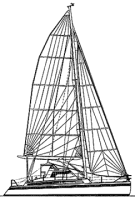Gerr 44
Multi Performance cruiser
Dave's client originally wanted a shorter boat (read shorter, fatter and slower). Dave suggested taking the given bulk of the proposed boat and stretch it out as long as possible in order to bring the boat into another realm of performance potential. The result is Slipstream, an unusual 44-foot cat that can teach us several lessons. Aesthetically, this boat doesn't do much for me, but cats are tough to judge on paper. You need to see them in the water to see how the bulk of the cabinhouse works with the expanse of the deck.
As designed, this boat weighs about the same as the 38-foot Prout catamaran, but it is 6 feet longer and 8 feet beamier. The benefits of this change in overall proportions should be obvious. Slipstream will be a rocket under sail. There are several design features to look at to understand how this shuffling of parameters works.
As you increase beam and LOA while maintaining displacement, you will gain in total shell area for both deck and hulls. This means that the displacement you have left over to finish the boat will be reduced. Therefore, the longer boat will not be able to have the same degree of outfitting as the shorter boat. Some things will have to go. Dave started this winnowing process by getting rid of two diesel engines, their shafts, struts, props and stuffing boxes and the accompanying fiberglass reinforcements and beds. Dave designed a retractable outboard motor to drive Slipstream. This saved both money and weight.
Compare the plan view of Slipstream with that of the Prout. Note that while the hulls of the Prout project very little from the perimeter of the molded deck, especially forward, Slipstream has almost no foredeck. The weight of the Prout's extensive, molded foredeck has been replaced with a trampoline between the hulls. So the accommodation pod is even shorter than that of the Prout, while the LOA is significantly greater. This is just a matter of balancing the accommodation requirements against the performance objectives, then factoring in the added cost of doing the longer boat. Even if displacement remains the same, indicating an equal amount of materials in the boat, the longer boat will require more man-hours due to the fairing requirements of the additional shell areas. In short, the cost per pound increases as the D/L decreases.
Following this approach, the interior of this boat is very simple. While almost all 44-foot cruising cats will have four staterooms, Dave's has only two. Each stateroom has its own head, which means each couple can have their own hull.
The cat's hulls are very skinny. The beam-to-length ratio for these hulls is 8.83. The Prout's is 7.6. Slenderness of the hulls has a direct bearing on the boat's hull speed. Waterline beam for Dave's cat is only 2 feet, 11 inches. This boat will slice through the water.
Construction uses Baltek balsa coring for both cabinhouse and decks. The hulls are Baltek A16000 precoated balsa core. Vinylester resin is used throughout.
Slipstream's modest approach to accommodations and accessories combined with attention to weight have resulted in a boat with superlative performance.

Comments